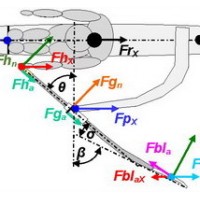Propulsive power and blade efficiency

The refined balance of propulsive forces previously obtained in RBN 2021/08 allows accurate analysis of the power transfer from the blade to the movement of the rower-boat system, which is the key point of Rowing Biomechanics. Description of the measurement methods and coordinate system were given previously and used here to derive the propulsive force applied to the CM of the rower-boats system Fsys.p. The drag force Fdrag acting on the boat hull was obtained with the method described in RBN 2019/01. The total force applied to the system CM Fsys was calculated as:
Fsys = Fsys.p + Fdrag (1)
Having the total force acting on the system Fsys and its mass msys (the sum of the rowers, boat and oars masses), an acceleration of the system CM asys can be derived:
asys = Fsys / msys (2)
An instantaneous velocity of the system CM vsys can be obtained with integration of its acceleration asys, then, applying an offset equal to the average rowing velocity (assuming it is steady). An instantaneous propulsive power Psys.p delivered to the system CM is the product of the propulsive force and velocity of CM:
Psys.p = Fsys.p vsys (3)
As the blade propulsion Fbl.p is the only external force acting on the system, it is also possible to derive the blade propulsive power Pbl.p:
Pbl.p = Fbl.p vsys (4)

Fig.1 shows above variables in M1x at 34.8spm (C2 Smoothie blades). The handle power Phnd derived traditionally is shown also. All three power curves (c) had similar magnitudes during the last third of the drive, but in the beginning, handle power was the highest (as the source of energy in input), the blade power was lowest (after losses in slippage), and the system power was intermediate (oar rotational inertia was added to the blade power).
Using the three types of power above, it is possible to derive the efficiencies of the power transformation processes as the ratios of their average values over the stroke cycle. This analysis has been applied to the recent data obtained in M1x using three different blade types: Smoothie, Comp and Fat2 (dimensions - in RBN 2020/11).

Rowing speed and power (Fig.2, Tab.1) were the highest in the first run with Smooth blades; gross DF was very similar, confirming consistent weather conditions.

The blade efficiency (Tab.2) defined with the slippage (RBN 2018/06) was the highest with Smooth, but these blades had the lowest ratio of the blade/handle powers, which could be related to a higher blade axial force in Smooth creating higher drag (Fig.2,a). The ratio of the system/blade powers was highest in the Comps (less axial force than in Smooth) and the lowest in Fat2, which could be explained by a shorter outboard – higher blade force – more slippage and the lowest efficiency of Fat2.

As magnitudes of Eblade.slip and Esys/handle were quite similar, and it is still not clear which one is more important, their average values were taken as an overall efficiency. Based on this, the Comp blades were the most efficient with 79.5%, Fat2 were the second with 77.6% and Smooth – the last ones with 77.4%. With the above levels of rowing speed and power, Comp would be 3.4s faster over 2km than Fat2, and 3.9s faster than Smooth blades. Similar results were obtained at lower stroke rates 20, 25, 30spm. More detailed discussion will follow…
Acknowledgements: Thanks to Concept2 Inc. and personally to Dick Dreissigacker and Alex Dunne for the interest and kind support of this study.
©2021 Dr. Valery Kleshnev www.biorow.com



